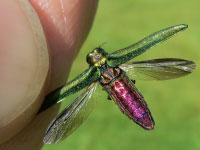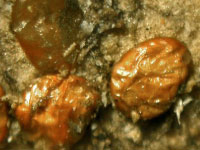Emerald Ash Borer
Life Cycle and Identification
Emerald ash borer (Agrilus planipennis) is an invasive, wood-boring beetle that kills ash trees (Fraxinus spp.) by eating the tissues under the bark. Native to northeastern Asia, emerald ash borer (EAB) was first detected in the United States in 2002 and is thought to have been introduced from China via the wood from shipping crates.
See where EAB has been found in Wisconsin and in the United States. Use the interactive map on the EAB portal to see if EAB has been found in your community and learn how to report new detections.
Learn the signs and symptoms of EAB and its potential impacts.
Life cycle and identification
Adults: Late May to September
Adults are very small beetles of a metallic green color. They are about the size of a cooked grain of rice: between 3/8- and 1/2-inch long and 1/16-inch wide. Due to their size, they can often go undetected, but they can be seen on ash bark and leaves during warmer months.
Adult beetles emerge from infested ash trees by creating a D-shaped exit hole that is about 1/8" wide. Most beetles will disperse less than 1/2 mile from their original location unless transported by humans in firewood or other unprocessed wood products.
Egg: June through September
Eggs are very small (1 mm), difficult to find and are rarely seen. Female beetles deposit them in bark crevices and as larvae hatch from the egg, they immediately chew their way into the tree.
Female beetles lay 40-200 eggs in the bark crevices of ash trees. They hatch in about two weeks.
Larva: June through October
Larvae are cream-colored and slightly flattened, with a pair of brown pincher-like appendages on the last segment. Their size varies as they feed and grow under the ash tree's bark. Fully grown, they average about 1.5 inches in length.
Larvae tunnel and feed in the nutritious tissue beneath the bark. They wind back and forth as they feed, creating S-shaped patterns called galleries under the bark. The larval stage is the most destructive because their feeding behavior disrupts the flow of nutrients through the tree. They feed under the bark for 1–2 years and can survive in green wood, such as firewood, if the bark is still attached.
Larval overwintering: October through May
After one or two years of feeding under the bark, larvae will create a chamber for themselves in the wood beneath the bark. Mature "pre-pupal" larvae are usually J-shaped.
Pupa: Spring
During the pupal stage, EAB larvae transform into adult beetles. During this process, features of the adult beetles become more apparent. The pupae, like the larvae, cannot be seen unless bark is pulled away from the tree.
The overwintering, mature larvae pupate inside the tree and gradually transform into adults. In autumn, after one or two years of feeding under the bark, larvae will create a chamber for themselves in the tree's sapwood. They stay in this chamber over winter and pupate in the spring before turning into adults. The beetles emerge from the tree, completing the life cycle.
Emerald ash borer look-alikes
There are many metallic green insects that are common in Wisconsin and often mistaken for EAB. For more information on these look-alikes, visit the University of Wisconsin–Madison's emerald ash borer webpage or see a side-by-side comparison of look-alikes. (Please note that the six-spotted tiger beetle may have any number of spots or none at all.)




